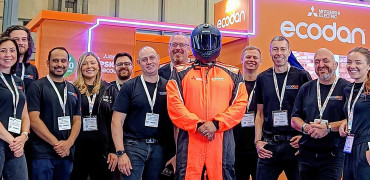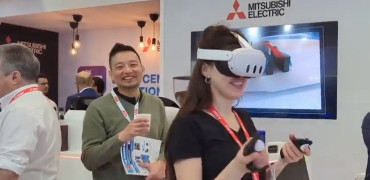I recently spent three days at the NEC in Birmingham at the Installer Show and I was delighted with the amount of interest we got in our Ecodan heat pumps on the stand.
We also had quite a bit of interest in our ‘beat the trainer’ challenge but I’m not allowed to reveal who our masked trainer was. All I will say is that it was rather hot in that helmet and boiler suit!
The event has grown steadily over the years, but this was the first time I really noticed significant growth in the number of ‘traditional’ heating engineers asking about heat pumps, which for me shows the way the industry is going.
One of the biggest attractions we had was our virtual reality tours of our equipment, which brings gamification to heating and HVAC, and helped to attract younger members of the Installer Show – those that are more used to using VR for alien shooter games!
VR can help show young people that there is a meaningful career for them in heat pumps
Seeing inside equipment
We went down the route of using virtual reality to ‘climb inside’ our equipment as part of the process of redesigning our training after the pandemic.
The first thing we did was put as much of our training online, in easy-to-learn modules that people can complete in their own time.
Then we developed a sophisticated webinar system that allows us to talk to up to 90 engineers at a time, where me and my fellow trainers can talk through a piece of equipment and test what the engineers have learnt in their online pre-sessions. (I say up to 90, but we could do far more than that. 90 just seems to be the limit in ensuring everyone can fully take part and get value out of the session).
The next step was to open our physical training courses again and we have completely revamped our training suites so that, having learnt a lot online, the engineers who do come into our training centres can get straight into being ‘hands-on’ with the equipment.
Added benefits of VR
I may be biased but I would say that our training centres are some of the best in the industry but even here there are limitations, which is why we have gone down the VR route.
Firstly, there is a limit to how many engineers we can get in our centres at any one time and, although we now have revamped training in Hatfield, Manchester and Livingston, with more to come at our other offices, there is a physical limit to how many engineers we can train face to face.
Secondly, whilst coming into the training room allows engineers to physically touch equipment, virtual reality allows them to go deep inside the equipment in a way that would be impossible in the real world.
This also has the advantage that we can create ‘dangerous’ situations in the virtual world that would have more serious consequences in the real one, such as loose electrical connections or other potential hazards.
Gamification of HVAC
And it also means we can show off much larger equipment that we would simply never be able to get inside our training rooms.
We have been over to Italy to one of our Chiller factories and filmed inside an IT Cooling system, and we plan to do more with Chillers, Heat Pump Chillers and Air handling Units.
And the one, really exciting thing about all of this for me, is the fact that we had so many young people coming onto our stand at the Installer Show.
We’ve already taken the VR system out and about in other areas as well, such as the recent WorldSkillsUK event in the centre of Birmingham and we’re looking at other STEM events where we can show students and other young people that there is a meaningful career for them that can help to make a real difference.
This is where VR is really coming into its own and showing that it was a really good investment.
Chris Thornton-Riley is a Technical Trainer




